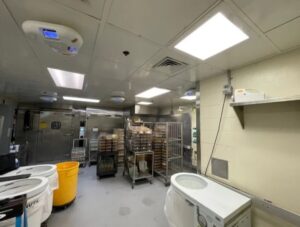Far-UVC light eliminates over 99% of airborne virus in an occupied room
A team from Columbia University’s Irving Medical Center have tested far-UVC light in real world conditions and the results were dramatic, with more than 99% of an airborne virus in an occupied work environment being inactivated.
Since Covid-19 there has been a surge of interest amongst the public about the use of UVC lamps for disinfectant purposes. Many products coming to market at that time claimed they could do things they couldn’t, while some were simply dangerous.

In a Which? report in 2021, Dr Gareth John from the Lighting Industry Association said: ‘Either the device under test doesn’t emit any UVC or doesn’t emit enough to be used as an effective disinfectant. Or, it emits UVC but in an unsafe manner. A UVC-emitting device should have safety interlocks to stop accidental skin and eye exposure, but we found a lot of products didn’t have them.’
Presciently, the article concluded: ‘That’s not to say that UVC products won’t have a role to play in the future. A certain wavelength, known as far-UVC, is thought to have potential to be safer, and when used safely and properly, UVC has its place in the broader arsenal of germ control options.’
Far-UVC light is much safer to humans than UVC because the wavelength range in which the light is emitted has no damaging effect on human skin or eyes but has been found to be effective at killing bacteria.
While conventional UVC light has been used to decontaminate rooms, it can only do so when the room is empty and is therefore ineffective at combatting any viruses subsequently brought into the room by people.
David Brenner, PhD, director of the Center for Radiological Research at Columbia University Vagelos College of Physicians and Surgeons and senior author of the study said: ‘You can decontaminate a room in the morning before people arrive, but it can quickly become contaminated again because people in the room are shedding viruses and other airborne pathogens. The goal is to be able to continuously decontaminate a room while people are in it.’
In recent years, Brenner and his team has been testing UVC light in the laboratory and found that far-UVC quickly and efficiently inactivates airborne pathogens in both small and room-sized test chambers. The new challenge was to test it in a populated room with high levels of virus in the air.
A room where laboratory mouse cages were cleaned provided the test setting as most mice carry a harmless form of norovirus, high concentrations of which become airborne when the cages are cleaned.
Four overhead far-UVC lamps were installed in the room and daily air samples were collected to compare infectious virus levels on days when the lamps were on and off.
The result was a reduction in infectious airborne viruses of 99.8%, which greatly surpassed expectations, as Brenner explained: ‘Based on our initial sensitivity tests, we expected to see a reduction in airborne virus of around 66%’
Brenner again: ‘If this virus had been a disease-causing virus, the far-UVC light would have provided far more protection against airborne-disease transmission than any ventilation system.’

















